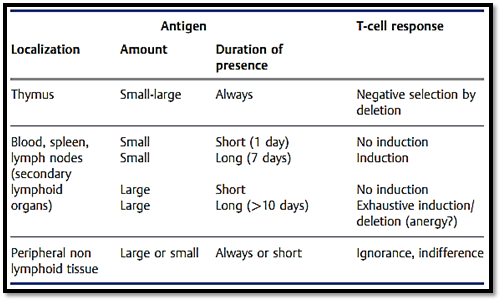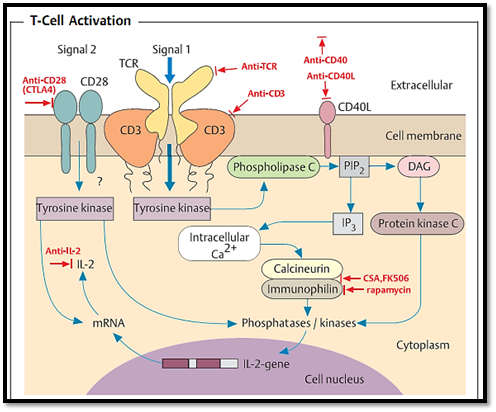


 النبات
النبات
 الحيوان
الحيوان
 الأحياء المجهرية
الأحياء المجهرية
 علم الأمراض
علم الأمراض
 التقانة الإحيائية
التقانة الإحيائية
 التقنية الحيوية المكروبية
التقنية الحيوية المكروبية
 التقنية الحياتية النانوية
التقنية الحياتية النانوية
 علم الأجنة
علم الأجنة
 الأحياء الجزيئي
الأحياء الجزيئي
 علم وظائف الأعضاء
علم وظائف الأعضاء
 الغدد
الغدد
 المضادات الحيوية
المضادات الحيوية|
Read More
Date: 6-11-2015
Date: 1-11-2015
Date: 6-11-2015
|
T Cells
T-Cell Activation
There are two classes of T cells; T helper cells (CD4+) and cytotoxic T cells (CD8+). Table 1 summarizes the reliance of T-cell responses on the dose, localization, and duration of presence of antigen. T-cell stimulation via the TCR, accessory molecules and adhesion molecules results in the activation
Table 1 Dependence of T-Cell Response on Antigen Localization, Amount and Duration of Presence

of various tyrosine kinases (Fig. 1) and mediates stringent and differential regulation of several signaling steps. T-cell induction and activation result from the activation of two signals. In addition to TCR activation (signal 1 = antigen), a costimulatory signal (signal 2) is usually required. Important costimulatory signals are delivered by the binding of B7 (B7.1 and B7.2) proteins (present on the APC or B cell) to ligands on the Tcells (CD28 protein, CTLA-4), or by CD40-CD40 ligand interactions. T-cell expansion is also enhanced by 1L-2.

Fig. 1 Regulation of T-cell activation is controlled by multiple signals, including costimulatory signals (Signal 2). Stimulation of the T cell via the T-cell receptor (TCR; Signal 1) activates a tyrosine kinase, which in turn activates phospholipase C (PLC). PLC splits phosphatidylinositol bisphosphate (PIP2) into inositol trispho- sphate (IP3) and diacyl glycerol (DAG). IP3 releases Ca2+ from intracellular depots, whilst DAG activates protein kinase C (PKC). Together, Ca2+ and PKC induce and activate the phosphoproteins required for IL-2 gene transcription within the cell nucleus. Stimulation of a T cell via the TCR alone results in production of only very small amounts of IL-2. Increased IL-2 production often requires additional signals (costimulation, e.g., via CD28). Costimulation via CD28 activates tyrosine kinases, which both sustain the transcription process and ensure post-transcriptional stabilization of IL-2 mRNA. Immunosuppressive substances (in red letters) include cytostatic drugs, anti-TCR, anti-CD3, anti-CD28 (CTLA4), anti-CD40, cyclosporine A and FK506 (which interferes with immunophilin-calcineurin binding, thus reducing IL-2 production), and rapamycin (which binds to, and blocks, immunophilin and hardly reduces IL-2 at all). Anti-interleukins (especially anti-IL-2, or a combination of anti-IL-2 receptor and anti-IL-15) block T-cell proliferation.
T-Cell Activation by Superantigens
In association with MHC class 11 molecules, a number of bacterial and possibly viral products can efficiently stimulate a large repertoire of CD4+ T cells at one time. This is often mediated by the binding of the bacterial or viral product to the constant segment of certain VP chains (and possibly Va chains) with a low level of specificity. Superantigens are categorized as either exogenous or endogenous. Exogenous superantigens mainly include bacterial toxins (staphylococcus enterotoxin types A-E [SEA, SEB, etc.]), toxic shock syndrome toxin (TSST), toxins from Streptococcus pyogenes, and certain retroviruses. Endogenous superantigens are derived from components of certain retroviruses found in mice, and which display superantigen-like behavior (e.g., murine mammary tumor virus, MMTV). The function of superantigens during T cell activation can be compared to the effect of bacterial lipopolysaccharides on B cells, in that LPS-induced B cell activation is also polyclonal (although it functions by way of the LPS receptors instead of the 1g receptors.
References
Zinkernagel, R. M. (2005). Medical Microbiology. © Thieme.



|
|
|
|
دراسة يابانية لتقليل مخاطر أمراض المواليد منخفضي الوزن
|
|
|
|
|
|
|
اكتشاف أكبر مرجان في العالم قبالة سواحل جزر سليمان
|
|
|
|
|
|
|
اتحاد كليات الطب الملكية البريطانية يشيد بالمستوى العلمي لطلبة جامعة العميد وبيئتها التعليمية
|
|
|